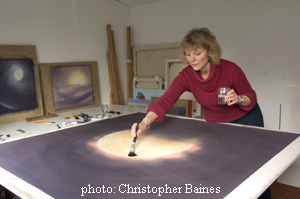biographies
Rebecca Hind
Rebecca Hind studied painting and printmaking at Bradford School of Art. Her works have since been featured in exhibitions throughout England and Wales, including an annual exhibition at the Royal College of Art (London), at A Space (Southampton) and Oriel (Cardiff). She was Project Artist for the nationwide Sacred Land Project between 1997 and 2003, through which she developed an interest in religious art culminating in the publishing of her first book: 1000 Faces of God, published by Carlton Press in 2004. Her DVDs ‘Painting In Watercolours - An Introduction’ and ‘Painting in Watercolours - Landscapes’ were published by Pickwick Press earlier this year.

Rebecca has taught Life Drawing at the Ruskin School of Drawing and Fine Art since 1998, and has led a number of printmaking workshops and life drawing classes at various Oxford establishments including Green College, Somerville College and the Ashmolean Museum. She is also a member of the Board of Directors for the Oxfordshire Visual Arts Festival and sits on the Visual Arts Committee at Dorchester Abbey. Rebecca is grateful to Arts Council England and Windsor and Newton for sponsoring the Moonscope exhibition.
Rebecca’s website is at www.rebeccahind.com
John Russell
John Russell was born in Guildford in 1745. After learning his trade with the painter Francis Cotes, he became a successful portrait painter, especially in pastel. He was elected to the Royal Academy in 1788 and the following year was appointed painter to the king, George III. As well as royal subjects, a number of other sitters were connected to the theatre or the church (Russell was an evangelical Christian), while others were scientists, such as the astronomer Sir William Herschel, the President of the Royal Society, Sir Joseph Banks, and the Astronomer Royal, Nevil Maskelyne. Russell himself was an active amateur astronomer, with an almost exclusive concern for the moon. He had a telescopes by Herschel himself and by Peter Dollond, and he devoted a great deal of time to recording accurately the appearance of the lunar surface. Much of this detailed study is preserved in an album of 180 sketches at the Museum of the History of Science, as well as the extraordinary large pastel, some 5ft across, which might be thought of as a portrait of the moon after a sitting of ten years. He also published a lunar globe and prepared the plates for printed planispheres that were published after his death. He died in Hull, after contracting typhus there in 1806.

